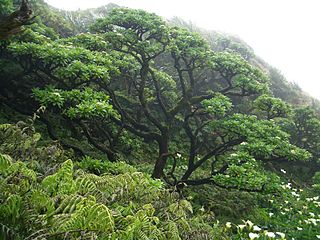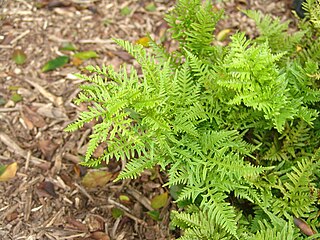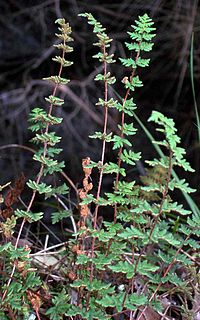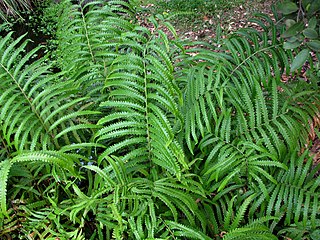
Pteris (brake) is a genus of about 300 species of ferns in the subfamily Pteridoideae of the family Pteridaceae. They are native to tropical and subtropical regions, southward to New Zealand, Australia, and South Africa, north to Japan and North America. 78 species are found in China. Some species of Pteris have considerable economic and ecological value, such as Pteris multifida, Pteris ensiformis, Pteris vittata can be used for ornamental purposes; as a hyperaccumulator, Pteris multifida and Pteris vittata can be used to control soil pollution.

The flora of Saint Helena, an isolated island in the South Atlantic Ocean, is exceptional in its high level of endemism and the severe threats facing the survival of the flora. In phytogeography, it is in the phytochorion St. Helena and Ascension Region of the African Subkingdom, in the Paleotropical Kingdom.

Pteris adscensionis is a fern species in the subfamily Pteridoideae of the family Pteridaceae. It is endemic to Ascension Island, and there are thought to be fewer than 500 individuals left in the wild. Its natural habitat has been severely reduced due to the large number of species introduced to the island when it was first settled in the 18th century.

Pteris vittata, commonly known variously as the Chinese brake, Chinese ladder brake, or simply ladder brake, is a fern species in the Pteridoideae subfamily of the Pteridaceae. It is indigenous to Asia, southern Europe, tropical Africa and Australia. The type specimen was collected in China by Pehr Osbeck.
Pteris platyzomopsis, synonym Platyzoma microphyllum, is a fern in the family Pteridaceae. When placed in the genus Platyzoma, it was the only species; the genus was sometimes placed in its own family, Platyzomaceae. The species is native to northern Australia, occurring in the Kimberley region of Western Australia, in the Northern Territory and Queensland, and in northern New South Wales, where it is considered endangered. Vernacular names include braid fern.

Pteris semipinnata is a fern species in the Pteridoideae subfamily of the Pteridaceae. It is mainly distributed in tropical regions, such as southern China, the Philippines, Vietnam, Laos, Thailand, Myanmar, Malaysia, Sri Lanka and northern India. It is also found in Japan and Bhutan. Pteris semipinnata grows in open forests, on the acid soil near streams or rocks, below 900 meters above sea level. It is native to Hong Kong and Taiwan. It should also be native to China. In any case, Hong Kong is currently a city in China, so it can be said that Pteris semipinnata is native to China.

Pteris umbrosa is a fern from eastern Australia. The habitat of the jungle brake is rainforest where it can form large colonies in shaded moist situations. There are several populations of this fern in the northern suburbs of Sydney. However, it is not clear if they are indigenous or escapees from gardens.

Pteridium esculentum, commonly known as bracken fern, Austral bracken or simply bracken, is a species of the bracken genus native to a number of countries in the Southern Hemisphere. Esculentum means edible. First described as Pteris esculenta by German botanist Georg Forster in 1786, it gained its current binomial name in 1908. The Eora people of the Sydney region knew it as gurgi.

Pteris tremula, commonly known as Australian brake, tender brake, tender brakefern, shaking brake is a fern species of the family Pteridaceae native to sheltered areas and forests in eastern Australia and New Zealand. It has pale green, lacy fronds of up to 2 meters in length, with an erect, tufted rhizome that is covered with narrow brown scales. It is fast-growing and easy to grow in cultivation, but can become weedy.

Cheilanthes sieberi is a small fern growing in many parts of Australia, New Zealand and nearby islands. Common names include poison rock fern and mulga fern.

Angiopteris evecta, commonly known as the king fern, giant fern, elephant fern, oriental vessel fern, Madagascar tree fern, or mule's Foot fern, is a very large rainforest fern in the family Marattiaceae native to most parts of Southeast Asia and Oceania. It has a history dating back about 300 million years, and is believed to have the longest fronds of any fern in the world.

Cyclosorus interruptus, the Hottentot fern or swamp shield-fern, is a fern in the family Thelypteridaceae. It is native to the tropics and subtropics in many parts of the world. In the New World, it is found from Mexico to Argentina, and in the Antilles. In the Old World, it is found in India, China, Malaysia, Sri Lanka and South Africa. It is also found in Australia, New Zealand, Hawaii and other islands in the Pacific Ocean. The various populations differ with respect to genetic cytotypes, glands, pubescence, and frond size. Its habitat is the vicinity of freshwater swamps and it may reach 1 m in height.

Actiniopteris radiata is a widely distributed fern occurring throughout Africa and adjacent islands, Madagascar, Arabia, Iran, Afghanistan, Nepal, India, Sri Lanka, Burma and Australia. It bears a close resemblance to Actiniopteris dimorpha Pic. Serm.

Pteris comans is a fern from eastern Australia and New Zealand. The habitat of the hairy bracken or netted brake is rainforest or moist open forest. The botanist Johann Georg Adam Forster published this plant in Halle, the year 1786, in his Florulae Insularum Australium Prodromus. The specific epithet comans is derived from Latin, meaning "covered with hair".

Alsophila ferdinandii, synonym Cyathea macarthurii, is a fern in the family Cyatheaceae.

Histiopteris is a genus of ferns in the family Dennstaedtiaceae described as a genus in 1875.

Pteris biaurita, the thinleaf brake, is a fern species in the genus Pteris. It is widely distributed around the world, including Africa, the Americas, and Asia. The plants are 70–110 cm in height, with erect, woody rhizomes 2–2.5 cm in diameter, and the apex densely covered with brown scales.
Pneumatopteris is a genus of about 80 species of terrestrial ferns in the family Thelypteridaceae. The range of the genus extends from tropical Africa, through Asia, Malesia and Australia to the Pacific islands, including Hawaii and New Zealand. It was first described by Japanese botanist Takenoshin Nakai in 1933. The name comes from the Greek pneuma, and pteris, with reference to the aerophores in some species.















